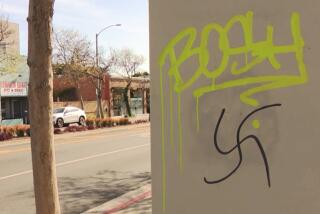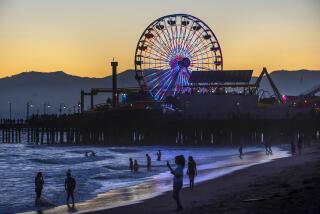Threatened by faith in Santa Monica
Christmas in Santa Monica has gotten a whole lot darker and a whole lot less tolerant. For almost 60 years Santa Monica’s Palisades Park embodied the Christmas spirit with its displays depicting the birth of Jesus. Through the use of large dioramas, the Christmas story unfolded chronologically, based on the Gospels of Luke and Matthew.
The life-size statues of baby Jesus, along with Mary, Joseph and others, added a visual reminder of our nation’s religious underpinnings. The Nativity scenes were an impermanent acknowledgment of the timeless role faith and organized religion plays for the residents of Santa Monica and visitors alike. No longer is that the case; the city has now prohibited the display of these dioramas on public land.
Two factors are driving this unfortunate ban. The first is a paralyzing fear of lawsuits.
In 2011, as a compromise with those opposed to the Nativity scenes, the Santa Monica City Council commissioned a lottery system to appropriate the public land on which religious-oriented displays were placed. By doing so, elected officials avoided bias toward any faith tradition. On the surface, it sounded reasonable. Most important for the city, it complied with 1st Amendment dictates and avoided the possibility of lawsuits.
With the lottery, groups opposing the Nativity scene could garner slots in Palisades Park to set up their own displays. Case closed, right? No. Those opposing the Nativity scenes won public space to do nothing more than distastefully convey messages that were inflammatory about Christianity and religion; messages that were the antithesis of the holiday spirit.
How did the Santa Monica City Council react? It closed the venue entirely — to everyone. No nuanced, sophisticated church-state remedies applied. No appreciation for historical precedent considered. Just no religion-based displays on public land, period.
Ironic coming from the same city that sanctioned the beautifully crafted statue of Santa (St.) Monica several hundred feet south of where the Nativity scenes were displayed. Farther south still, next to the civic center, sits another city-sanctioned piece based on a Paul Conrad cartoon, titled “Chain Reaction.” The antiwar sculpture depicts a nearly three-story-high atomic bomb’s mushroom cloud. That value-based — and controversial — message is acceptable when placed on public ground. The Nativity, even when displayed temporarily: absolutely not!
The second factor driving this unfortunate ban is an unprecedented, angry form of atheism.
Today’s atheism is different from the atheism of the 18th, 19th and 20th centuries. Nietzsche, Russell and Voltaire did not gloat over the presumed death or nonexistence of God. There was no triumphalism in their assertions. While not enamored of organized religion, they did not view it as a singular force for evil.
Things have changed. Outspoken, angry 21st century atheists like Richard Dawkins, Sam Harris and the late Christopher Hitchens have sought to eradicate God and organized religion from the planet; faith-based religion in any form is unacceptable to them. When studying these modern-day thinkers, the late Herbert Marcuse’s lament proves fitting and prescient: “We, no matter the side, become fanatical in our own anti-fanaticism.”
Today’s atheists hold that religion educates children and adults to hate in the name of their pious doctrines. Religion, they tell us, encourages followers to engage in God-directed slaughter and conquest of innocents. Its mission is to convert skeptics — or worse, subdue nonbelievers — until the whole world buckles.
The truth is, they’re partly right. There have always been people who commit evil in the name of God and religion. They do indeed give religion and God a horrible name. Such behavior is perverse, inexcusable and, of course, sinful.
But today’s atheists are as extreme in their convictions as the fire-and-brimstone believer. The resolute follower knows beyond any doubt that God exists, whereas the atheist knows beyond any doubt that God is a figment of the imagination. I’m reminded of the aphorism: To the believer there are no questions; to the atheist, there are no answers.
As a Jew and a rabbi, my speaking out in support of Christians who wish to display a Nativity scene on public land can potentially carry more weight than a priest or minister speaking out. The reason is simple: It’s not my religious narrative. More important, faithful Christians do not threaten me. If anything, I’m inspired by them. By definition, different people from different faiths view God and religion differently.
In the meantime, Santa Monica, where I live and serve a congregation, is less festive, bright and accepting this Christmas season. And given my city’s current municipal policy — one that forbids the use of public
land for any outward religious expression, even for something as non-threatening and temporary as a Nativity scene — I suspect it will remain that way for a long time. Sadly, we are all — Jew, Christian and, yes, atheist — poorer for it.
Michael Gotlieb is rabbi at Kehillat Ma’arav, or the Westside Congregation, in Santa Monica.
More to Read
A cure for the common opinion
Get thought-provoking perspectives with our weekly newsletter.
You may occasionally receive promotional content from the Los Angeles Times.






